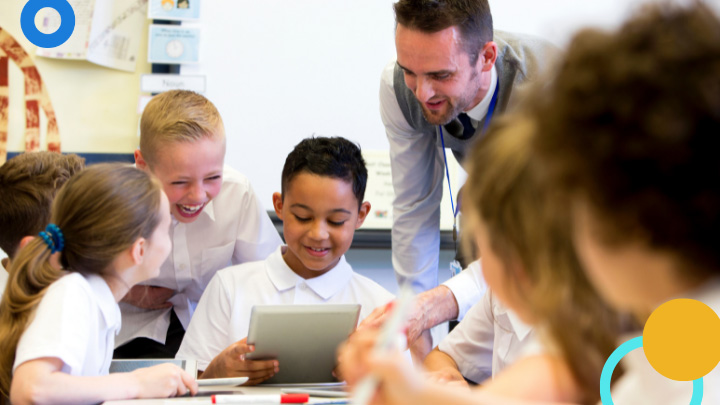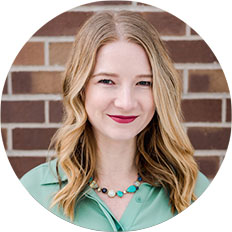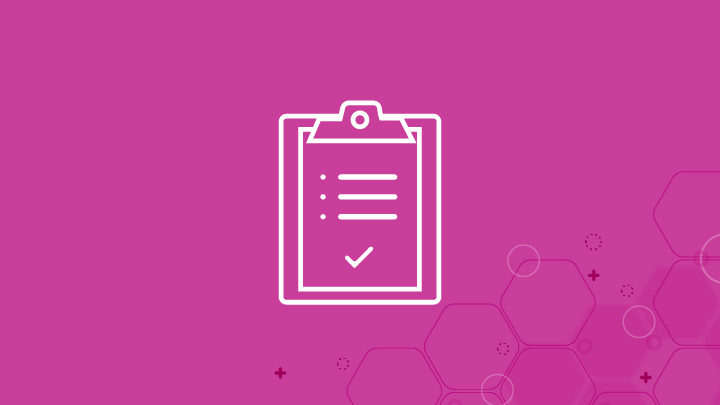Introducing Bryanna
When I first met with Bryanna, I learned that she was teaching third-grade humanities at a charter school in Camden, New Jersey. She was teaching in an inclusion setting using the EL Education curriculum. When I began that first coaching session with Bryanna, I could see how much expertise she had in close reading strategies, social-emotional learning, and data-driven instruction. She also shared that many of her students were well below a third-grade reading level. I knew that she would have big goals and I was excited to personalize her coaching to her goals.
To begin our work, I shared a little bit about coaching, the try-measure-learn process, and how we use outcomes (goals) to guide coaching and achieve clear milestones. Bryanna chose her first outcome in the focus area of formative assessment and differentiation:
I can create a culture of feedback with my students by developing trust in order to drive their academic growth.
When discussing her goals, she shared, “I want students to hear feedback and emotionally be motivated to act on it and then I want a revision process to happen.”
She continues, “It was clear early on that students were invested in being back in the classroom and with a teacher full time. I quickly learned that the needs of students were so varied that one strategy or mindset couldn’t work alone. My feedback would need to be consistent and targeted for each student. The word that became my foundation and guide was: goals! The goals were varied but the steps we could take to achieve them could be universally applied.”
At the end of our first session, Bryanna was already excited to try something new towards her overall plan to create a culture of feedback for goal setting. She planned to use her lesson’s learning targets to create “criteria for success,” or thinking steps so that students could begin to self-assess and take feedback centered around those learning targets. This began their process of learning target self-assessment.
Bryanna reflected on this process: “Students began to self-evaluate their work and progress during work time without having to be reminded of the next step—the thinking steps and criteria for success were given on their actual work or visible on the board/screen, giving the class a common language for feedback. The steps gave students the opportunity to advocate for themselves when stuck on specific parts or celebrate when they monitored their work because they could see success immediately. These strategies were very logistical in nature but it became the norm: we have work to do; here’s how we are going to do it.
These components were the foundation of feedback and self-evaluation. When I first introduced each structure, I explained the purpose behind them and why they were important to include in our daily routines.
Here was our plan:
Learning Targets
Learning targets/goals would need to be super clear at the beginning of the lesson but also used in the language throughout the lesson. EL Education has strong learning targets that are standard specific, which helps the class adopt a common language for goals.
Thinking Steps
No one gets where they want to be right away—there is a process, timeline, or a set of steps to climb before we can achieve success. Steps given in lessons or within units could be agendas, timelines, thinking steps, etc. I aimed to frame thinking steps as open-ended questions to enhance critical thinking. Giving students thinking steps that can be answered with a yes/no can limit their engagement in higher-order thinking.
Checklists
One of my favorite strategies (in life and school) is checklists! Checklists organize the process and the outcome in such clear ways. They give students the opportunity to know exactly how to get the outcome they desire, understand what pieces they might be missing, and create accountability. Paired with the thinking steps (see example below), a checklist gives the class a common language of the standards, process, and outcome. Having the checklist as a visible, active part of the lesson also gives me as the teacher a chance to be specific when giving feedback.”
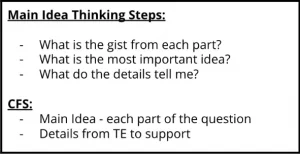
An example of Bryanna’s thinking steps & CFS for her students.
Building on that Foundation with Goal Setting
After Bryanna created a culture of feedback using learning targets, thinking steps, and checklists, we reflected on the next step. We moved into planning out goal setting. Students would use their self-assessments to set goals using a red, yellow, and green half-sheet tracker. If they were in the red or yellow, they knew that was an area they should focus on for goal setting.
Bryanna planned to roll out this process using SMART goal setting. She would teach what SMART goals are, show her own goal to model for her students how to set a goal and make a plan, and give examples of goals. She would then allow her students to set their first goals while she conferenced with them each individually. She would do this while students worked independently during flexible time on iReady lessons or assessments.
“Goal setting was a natural progression for the work we started around thinking steps and having rubrics and checklists during the lessons,” Bryanna shared. “Students were building confidence, the content was elevated, and we were out of the newness of routines and procedures. We started off analyzing our learning target progress with an easy self-assessment tool on their desks. At the end of every lesson or section, students would be asked to choose a color based on how they were feeling about their progress towards mastery of the learning target.”
Here’s how Brynna communicated the code:
Red: I can’t do this independently yet; I’m confused.
Yellow: I know I will do this independently; I have a question OR I need more practice.
Green: I’m very confident I can do this independently; I’m ready for a new challenge.
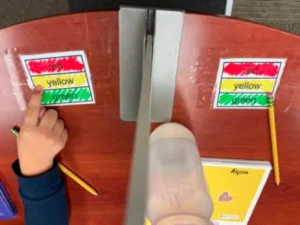
An example of the red, yellow, green tracker Bryanna used.
Making Improvements to Goal Setting
In another coaching session, we discussed how Bryanna had achieved her outcome around a culture of feedback. Bryanna reflected: “I think creating a class vocabulary and class routines has allowed kids to be okay with where they are at and to celebrate their wins and create their personal goals/next steps.”
Bryanna was ready to move to her next outcome around tracking progress:
I can support my students to track their own progress by having them understand and take ownership of their learning data.
Bryanna’s goals were to help students track their progress with self-assessment/goal setting and to use data from assessments and goal setting to recognize and celebrate when they had achieved a goal.
As Bryanna continued implementation, we used our next few meetings to acknowledge successes, or “glows,” and make tweaks where necessary. Students loved the red, yellow, green self-assessment tool and wanted to use this tool for everything—not just academics! Bryanna also found that quieter students felt more comfortable sharing their status using this tool.
“Over time, this became so routine that if students noticed others progressing faster or having an easier time with the lesson, they would discreetly use their pencil to point to yellow or red when I walked by to signal to me that they needed help. Some would be verbal with their progress. ‘Ms. Costello, I’m at a yellow right now,’ and then follow it up with their question or something they just didn’t quite grasp,” Bryanna told me.
Bryanna scaffolded goal setting by sharing the week’s focus at the start of each week so students could use that to create relevant goals. For example, for a focus around the main idea of what they were reading, one goal could be “I can use two pieces of text evidence to support the main idea.”
One area that needed tweaking was the organization of it all. She wanted to change the format so that everything was in one place and students didn’t need so many papers. Bryanna’s idea was to create goal notebooks for students. This was the start of what eventually became “goal passports.”
“Our theme for the year has been ‘reading takes us places!’ and having students set goals in a passport just seemed like the perfect holding place for all the ‘places’ we could go within our reading journey,” shared Bryanna. “We spent time each week creating goals based on what skills were coming up for the week.
Here’s an example of the weekly plan:
- On Mondays, we spent time with our agenda for the week of skills that we would practice.
- Throughout the week, we could use standard language and reference thinking steps and CFS.
- On Fridays, students would evaluate their work from the week. Inside their passports, students would write reflections on their progress. If students met their goals, they would receive a stamp in their passports!
Feedback throughout this process anchored their motivation. Students discussed their progress, and goals and connected with (and encouraged!) others. Students felt confident giving each other constructive feedback.”
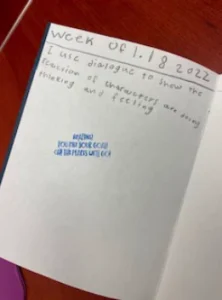
An example of one student’s goal passport with a stamp!
Final Reflections
This process of tracking progress and recognizing growth allowed Bryanna to reflect on her own growth. She not only created a culture of feedback, but she now had a classroom community of students who took ownership of their learning data and were motivated to improve!
Upon reflection, Bryanna said, “I think that students are better able to advocate for their strengths and weaknesses and they also have enough self-awareness to ask ‘how do I reach this goal?’ if they don’t know how to get there, which is helpful in their ownership and they’re super motivated by data which is awesome!”
In our final few meetings together, Bryanna shared what these systems look like in her classroom now. They don’t look the same as they did in October and November.
“It’s evolved with them,” she shared. “The red, yellow, green was necessary at the point that I did it because they needed to be able to be reminded that they can advocate for themselves and then we got to a point where they didn’t need that because they were more verbal on their own. One kid said to me, ‘I think I’m okay with summarizing the problem and solution, but I’m stuck here on this call to action; how do I question them?’ He picked apart the checklist and said ‘okay, this is what I got and this is what I can do on my own and this is the piece I need help with….’ In the beginning of the year, he was a kid who would shut down and slam his pencil and say, ‘I don’t know how to do this.’ Now, he just evaluated the entire list on his own and is telling me what he needs from me!”
This was a special moment for me to witness as a coach. Bryanna allowed her students to grow not just academically, but emotionally. She helped them to advocate for themselves, grow their confidence, and become more independent and self-driven learners. It was wonderful to see this develop throughout the year!
“The culture I built with my students this year, around feedback and academic growth, mirrored strategies and routines that can and will be helpful as transferable skills in other areas of life. As adults we set goals, make plans to achieve them, and understand that we meet our goals with clear action steps and often the encouragement of a support system that believes in us and is able to guide us or watch us grow.
Having Morgan coaching me through the year has been such an asset to the ways I could cultivate a strong school year. We worked together to make my ideas come to life in the classroom. She guided me to strategies for anything that I needed over the year. It was incredible to form a strong relationship with someone I could trust and count on in such a small amount of time.“
If you’re ready to learn more about coaching with BetterLesson, contact us today.
Let's Talk